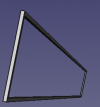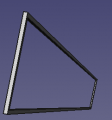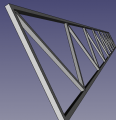CNC Sawmill: Difference between revisions
Jump to navigation
Jump to search
| Line 16: | Line 16: | ||
File:cncsaw.png|'''Sawmill.''' - FreeCAD -[[File:cncsaw.FCStd]] | File:cncsaw.png|'''Sawmill.''' - FreeCAD -[[File:cncsaw.FCStd]] | ||
File: | File:cncsaw2.png|'''Sawmill truss.''' - FreeCAD -[[File:cncsawtruss.FCStd]] | ||
</gallery> | </gallery> | ||
Revision as of 13:48, 13 June 2021
Working Doc
Part Library
Part Library
Visual History:
Sawmill. - FreeCAD -File:Cncsaw.FCStd
Sawmill truss. - FreeCAD -File:Cncsawtruss.FCStd
Options
- Use a 16" circular saw with 2" universal axis. Advantage: turnkey saw. Dis: small cuts only up to 4 or 6", slow (power only 3 hp)
- Use long space frame axis for stability, mount on trailer or SMV
- Use mobile stiff frame on wheels
Industry Standards
- China wares - [1]
- Lucas Sawmill - [2] - setup time with wires for stability is a disadvantage. Solid space frame for moving the OSE mill into the field would help. Peterson [3] setup time is no better. But, it can be set up in the field on rough terrain.
Decisions
- Portable or stationary
- Rough terrain or not
- CNC or manual
- Easy to set up (solid frames) vs not (multi-piece frames with need to align)
- Hand portable vs heavy, requiring other machines to move it
- Production (32 hp - 100 hp) vs hobby (7 hp - 27 hp)



